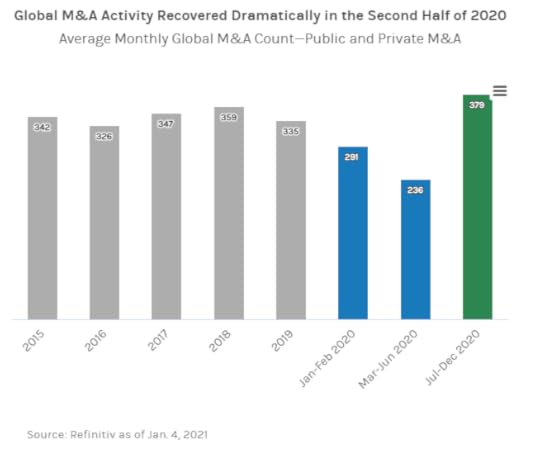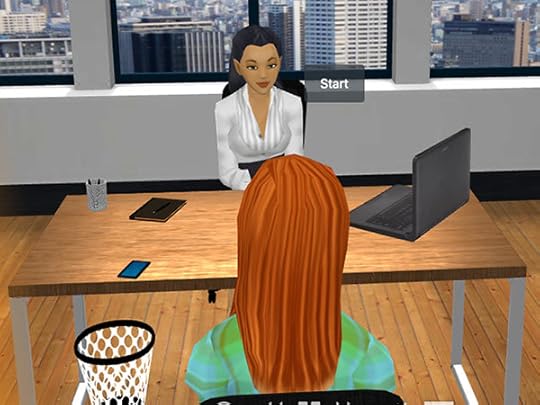Susan Scott's Blog, page 24
September 2, 2021
Back to School
It’s officially September! Which means classrooms (in-person and virtual) are filled with minds eager to learn. And while many of us enjoy learning new skills and information, it can be difficult to get back into “learning mode.” In his newest vlog, Fierce Master Facilitator Paul Stabile reviews the importance of continuing education and the many modalities offered to help get you started.
 5 Conversations You Need To Start Having Today
5 Conversations You Need To Start Having Today Learn how to successfully navigate the most common conversations with this free eBook.
Tags: #Employee Engagement
The post Back to School appeared first on Fierce.
August 17, 2021
How to Be More Present in Your Conversations to Succeed at Change

Raise your hand if you have experienced any change in your life this year. Silly question, I know. We all have experienced far more change than we ever bargained for. And it hasn’t been easy. There are no two ways about it, change is hard, and it’s persistent. And just as we individuals have experienced copious amounts of change in the last year and a half, so have the organizations we work for. Ever heard the saying, “Organizations don’t change, people do”? The cumulative impact of individual change leads to shifts (large and small) in a business. If people didn’t change, organizations wouldn’t be able to either.
Chief executive of IBM for nearly a decade, Lou Gerstner led one of the most successful business transformations in history. He said the most important lesson he learned from his experience in change and transformation is that “culture is everything.” He didn’t say the biggest lesson was the change methodology they used or the clarity of decision rights or reporting structure. He said the key was in the “culture.” Tend to your organization’s culture (the people), and it can significantly impact your change efforts for the better.
And yet, while most of us know intuitively that a healthy organizational culture is vital to successful change efforts, culture tends to be the first casualty during times of change. We hear things such as “they need to communicate better about this,” or “they aren’t looking out for our best interests,” or “they don’t care about me. They just care about their bottom line.” The culture becomes fractured into two opposing groups – us versus them.
According to Daniel Pink in his book “Drive,” When Robert Reich was U.S. Secretary of Labor, and he visited a company to talk with the employees, he would often conduct a “pronoun test” to determine the cultural health of that organization. He found employees who referred to their company in terms of “we” were more engaged than those who referred to the company as “they.”
When your employees buy into what you are doing (i.e., a major change effort), they tend to take more ownership.
When they are satisfied, they say things like “look at everything we’ve accomplished!” or “We are getting things done!”
When they’re dissatisfied, they disconnect. Employees start to say things such as, “they aren’t communicating with us” or “They need to fix that.”
Reich concluded that an employee who uses “we” feels more integrated, identifies more with the company and takes more ownership. This leads to employees who are more likely to be satisfied, engaged and effective at what they do. There’s a sense of belonging to the organization and a deep understanding of shared culture.
Bottom Line? Whether you are a new leader on a team, implementing a new program, instituting your fifth “covid” working arrangement, or working on merging two companies, focusing more deliberately on the people and the connections you’re creating with them has a direct impact on the success of the change you’re trying to make.
So how can we as leaders ignite our employees’ deeper connection, cut through the resistance to change and thrive?
Build Trust through Conversation.When we trust the people who we work with and work for, we want to show up. We want to succeed. Trust in others promotes teamwork, aids in conflict management and fosters creativity during times of uncertainty. There’s a sense of camaraderie – we feel connected, we feel a part of the process.
Trust comes not just from what you say but how you say it and how you behave after it’s been said. In the longer term, you build trust based on your persistent identity or how you show up with others repeatedly. Trust comes from the quality of the conversations you are having. The more honest and authentic the conversations, the more likely you will have a more trusting relationship. This is applicable both at the organization and the individual level. If the conversation stops, becomes muted, or our dialogue consists only of top-down formal messaging with no real exchange, no real conversation, then all the possibilities for the individuals in that relationship, all the possibilities for what those individuals are trying to achieve, become smaller.
The simplest way to build trust in your conversations is to be here, prepared to be nowhere else.
In other words, really be present. The last time you spoke face-to-face with someone, were you looking at them or were your eyes roaming the room in a sort of perpetual surveillance? During your last phone conversation or Zoom call, were you genuinely listening, or were you scanning your email or sending an IM? Being “present” sounds simple, yet during times of change, our mind may be anywhere but “here.”
Sometimes the greatest gift we can give another is the purity of our attention. It takes effort. But when we focus on the here and now, rather than thinking about the agenda for our next meeting or the project plan that needs our approval, our conversations, our relationships and our outcomes are far richer, more meaningful and more productive.
When you are present with the people important to you, in a way that they feel individually seen, valued, heard and recognized, they are more likely to become present and engaged with you – you build trust.
And although we might think we don’t have the time and energy to be completely present during every single conversation, we actually don’t have the time and energy not to. When we are not present, we miss each other. We may hear every word and yet still miss the message entirely. And because missed messages often lead to misunderstanding, we’ll need to spend time and energy resolving them later.
Increasing the quality of the conversations you are having will help you build more trust and more emotional capital with your team, which will have a direct impact on supporting the change(s) you wish to implement.
So, ask yourself – who would benefit from your undivided attention?
 5 Conversations You Need To Start Having Today
5 Conversations You Need To Start Having Today Learn how to successfully navigate the most common conversations with this free eBook.
Tags: #Employee Engagement, #Mergers and Acquisitions
The post How to Be More Present in Your Conversations to Succeed at Change appeared first on Fierce.
August 10, 2021
International S’mores Day Fireside Chat
Join Fierce Master Facilitator Paul Stabile for a very special fireside chat with our newest Fierce Master Facilitator Ellen Steinlein!
Ellen has been a researcher and practitioner of Organizational Psychology over the past 16 years focused on elevating the employee experience throughout the hiring, onboarding, performance management, and professional development lifecycles. Outside of the world of employee engagement, Ellen spends her free time playing badminton, tennis, and pickleball. She lives in Colorado Springs with her husband, 3 children, and 2 dogs.
International S’mores Day is August 10, 2021.
 5 Conversations You Need To Start Having Today
5 Conversations You Need To Start Having Today Learn how to successfully navigate the most common conversations with this free eBook.
Tags: #Employee Engagement
The post International S’mores Day Fireside Chat appeared first on Fierce.
August 3, 2021
The Power of Listening Well for Successful Mergers

Over the past 15 years, I’ve had the opportunity to work for various companies where I’ve come across some exceptional leaders. Regardless of the industry, whether for-profit or nonprofit, public or private, two types of leaders always stand out. The first type are those who lead by sharing a compelling vision, always having the right answers and tackling tough challenges head-on. Then there are the leaders who focus on connecting with others, consistently gathering insights from multiple perspectives and spend time building relationships. Both are great leaders, but the glaring difference is that the latter are the leaders who gain genuine followership, fierce loyalty and a deep-seated trust among employees and peers. What makes the difference? It’s the ability to listen well. When thinking about mergers and acquisitions (M&As) and supporting people through change, this unique ability to listen well is a significant contributor to success or failure. Those who listen well create an environment that engages employees through challenging organizational transitions. Those who don’t encounter passive resistance to change.
The global pandemic challenged every company to re-evaluate the way they do business. Organizational leaders carefully reviewed their portfolios to reassess their strategies for growth. This led to strategic mergers and acquisitions that hit historic levels as companies sought to acquire capabilities and increase market share, profitability and competitive advantage. In the third and fourth quarters of 2020, the pace of M&A announcements hit a record of 1,250 global transactions, totaling more than one trillion dollars. Additionally, the PwC 4th Annual Global CEO Survey (2021) found that 76% of CEOs expect global economic growth to improve in the next 12 months.
With the pace of M&As exceeding expectations, it’s essential to recognize that most of them, up to 75%-83%, fail. In a study completed by KPMG, 80% of these failures were due to poor execution of change management strategies. A survey of Fortune 500 Chief Financial Officers found that 45% of leaders attributed the failures to “unexpected post-deal people problems.”

Research around change management in M&As has indicated that the driver of successful mergers centers around having a solid communication strategy. While I agree that communication is key, I want to emphasize that it is not simply the talking, sharing, presenting or painting the path forward aspects of communication that determine success. It is the listening well aspect. Theodore Roosevelt once said, “people don’t care how much you know until they know how much you care.” When it comes to M&As, the truth of this quote is magnified exponentially.
Why Mergers FailWhenever a significant change occurs, most organizations invite senior leaders to offer ‘shared vision’ tours. Their strategy is to overcommunicate why the change is happening, how it will benefit the organization and what to expect. It is assumed that the rest of the organization will hop on the bandwagon and embrace the change because there was a solid communication strategy before, during and after the change. They’re surprised when change is received poorly — when people simply refuse to adopt new ways of doing things or when top talent simply leaves the organization in droves. But looking back, did the company listen well to their employees?
The power of listening well — gathering multiple, and even competing perspectives — helps employees recognize that leaders do care, they want to understand and they truly appreciate everyone’s voice. Even if employees disagree with the decision to merge, their input is sought out, their concerns are heard and they now have a better understanding of everything involved in making the decision.
Establishing Your Listening Well StrategyHere are some powerful listening well activities and questions to think through as you prepare your employees for a merger and acquisition.
Listening Well Before the Merger:Which departments or groups of employees might have the most difficult time adjusting to the change? What questions can I ask to understand their concerns? Which groups across the organization might be most excited about the change? How might their enthusiasm be leveraged? What are the most important communication channels to utilize when demonstrating that the ‘new organization’ truly wants to listen well? How might you circle back to those who have shared their input? Listening Well During the Merger: Which groups seem to have adapted to the M&A initiatives well? Which groups are lagging? What factors contribute to these results? Which employees have most used communication channels during this M&A to share their perspectives? Which do they seem most comfortable with? How might more of those opportunities be created? What are the most common challenges and concerns voiced during the transition? How might those concerns be addressed transparently? How frequently have different perspectives been sought out? How has the organization made adaptations based on the feedback during the transitional period? Listening Well Post Merger:Continue to provide ‘listening well’ channels to employees to keep a pulse on how the merger has impacted employees. Ideas include:
Scheduling virtual and in-person forums dedicated to discussing how the merger is going. Providing a company-wide anonymous feedback inbox regarding the transition. Encouraging managers to include questions about how the transition has impacted employees during check-ins. Creating a company blog dedicated to answering ongoing questions and sharing important information about the transition.Organizations that listen well succeed. While a strong communication plan is an essential part of change management, the secret to success is to truly engage employees by listening well. Actions must demonstrate a sincere desire to understand employees’ thoughts, ideas and concerns. Listening well also requires follow-up to what was heard and creating space for a two-way conversation. If leaders practice some of the strategies listed above to listen well but fail to follow up, it risks becoming the ‘illusion of inclusion.’
Whether your organization is going through a merger, acquisition or implementing a new strategy, recognize that a foundational key to successful change management is listening well.
 5 Conversations You Need To Start Having Today
5 Conversations You Need To Start Having Today Learn how to successfully navigate the most common conversations with this free eBook.
Tags: #Employee Engagement, #Mergers and Acquisitions
The post The Power of Listening Well for Successful Mergers appeared first on Fierce.
July 22, 2021
How to Take the Vacation You Need
44% of employees didn’t take a break last year, and those who did weren’t fully disconnecting. But taking breaks is a vital part of success at the individual, team and even organizational level. Worn down, stressed-out people make mistakes that jeopardize the quality of work being done.
Watch this video with Fierce Master Facilitator Paul Stabile to discover what you can do to disconnect and allow yourself that mental refresh for your overall health and well-being.
 5 Conversations You Need To Start Having Today
5 Conversations You Need To Start Having Today Learn how to successfully navigate the most common conversations with this free eBook.
Tags: #Employee Engagement
The post How to Take the Vacation You Need appeared first on Fierce.
June 22, 2021
How to Reboard Your Employees After COVID-19
Are you planning to go back to the office five days a week? Has your company shifted to a fully remote workplace? Or is leadership busy building a hybrid structure for employees? No matter what the future of your workplace looks like, our “new normal” is shifting once again. And it’s just as important, if not more, to get the transition right this time.
Watch this video to discover what leaders need to know about reboarding employees and how your organization can transition successfully.
 5 Conversations You Need To Start Having Today
5 Conversations You Need To Start Having Today Learn how to successfully navigate the most common conversations.
Tags: #Employee Engagement, #Leadership Development
The post How to Reboard Your Employees After COVID-19 appeared first on Fierce.
May 20, 2021
Curbing Bias and Improving Teamwork Through Virtual Training
For the past year, the nation has been engaged in uncomfortable conversations about race and culture. These conversations have prompted discussions in companies around the world. We saw a broad outpouring of support from corporate leaders over the past year who have denounced racial injustice and vowed to change the culture of their organizations to combat unconscious bias, microaggressions and in the end, promote an environment where team members can work collaboratively, improving teamwork, and increasing productivity.
Today, corporate leaders can look at any of the growing numbers of virtual reality (VR) and simulation tools available that recreate real-world scenarios. Through self-paced learning, these innovative technologies allow employees to test their knowledge of unconscious bias, understand how their words or actions may translate to microaggressions, and discover how to better respond and act in everyday conversations.
In this Training Mag article, Fierce CEO Ed Beltran discusses how virtual training and 3D Simulations can help users uncover and address unconscious biases and microaggressions.
Read: Curbing Bias and Improving Teamwork Through Virtual Training
 10 Steps to be Fierce at Work and at Home
10 Steps to be Fierce at Work and at Home Learn how to successfully navigate your work and home life with this free eBook.
10 Steps to be Fierce at Work and at Home >
Tags: #3D Simulations, #Innovation
The post Curbing Bias and Improving Teamwork Through Virtual Training appeared first on Fierce.
5 Bad Habits Remote Workers Need To Bust (And Ways To Do It)

Over the past year, the switch to remote work spread across the globe as quickly as the virus, in an effort to keep people safe while maintaining business continuity. As many companies decide that remote or hybrid work environments are here to stay, it’s important to ensure that communication is always clear and open to keep productivity levels high.
Let’s explore some of the unintended consequences of remote working and bad habits that people may develop over time. And how to fix them!
In this Fast Company article, Fierce CEO Ed Beltran discusses the importance of taming stress and striking a healthy balance in work and in life.
Read: 5 Bad Habits Remote Workers Need To Bust (And Ways To Do It)
 10 Steps to be Fierce at Work and at Home
10 Steps to be Fierce at Work and at Home Learn how to successfully navigate your work and home life.
10 Steps to be Fierce at Work and at Home >
Tags: #Company Culture, #Digital Transformation, #Innovation, #Soft Skills
The post 5 Bad Habits Remote Workers Need To Bust (And Ways To Do It) appeared first on Fierce.
May 13, 2021
Fierce Named IndustryWired’s Top Digital Transformation Companies

Fierce Conversations has been named one of IndustryWired’s Top Revolutionary Digital Transformation Companies of 2021!
How we communicate is key to building and enriching relationships, as well as succeeding in the fast-paced world of business. Ed Beltran, CEO of Fierce Conversations, shares how our innovative work impacts the industry in an exclusive conversation with IndustryWired.
Read the feature on IndustryWired
 10 Steps to be Fierce at Work and at Home
10 Steps to be Fierce at Work and at Home Learn how to successfully navigate your work and home life.
10 Steps to be Fierce at Work and at Home >
Tags: #Company Culture, #Digital Transformation, #Innovation, #Soft Skills
The post appeared first on Fierce.
May 4, 2021
How To Offset Stress and Achieve Work-Life Balance
We all get that too much stress can have a negative impact on the quality of our daily lives, but how is it possible to strike a balance between work and life when everyday is Blursday?
At Fierce Conversations, the positive steps we take toward better work-life balance start with conversations and communication to diminish anxiety levels and enrich relationships. Discover simple hacks that can turn pressure into motivation and free up precious time in your day.
In this Forbes article , Fierce CEO Ed Beltran discusses the importance of taming stress and striking a healthy balance in work and in life.
Read: How To Offset Stress And Achieve Work-Life Balance
 10 Steps to be Fierce at Work and at Home
10 Steps to be Fierce at Work and at Home Learn how to successfully navigate your work and home life.
10 Steps to be Fierce at Work and at Home >
Tags: #Company Culture, #Job Stress, #Mental Health
The post How To Offset Stress and Achieve Work-Life Balance appeared first on Fierce.
Susan Scott's Blog
- Susan Scott's profile
- 859 followers





